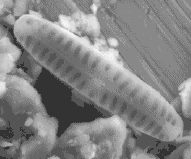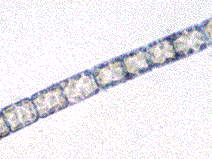







Diatoms may be extremely abundant in both freshwater and marine ecosystems; it is estimated that 20% to 25% of all organic carbon fixation on the planet (transformation of carbon dioxide and water into sugars, using light energy) is carried out by diatoms. This is possible because they contain chlorophyll. Diatoms are thus a major food resource for marine and freshwater microorganisms and animal larvae, and are a major source of atmospheric oxygen.
Diatoms are a major component of plankton, free-floating microorganisms of marine or freshwater environments. Not all diatoms float freely though; many cling to surfaces such as aquatic plants, molluscs, crustaceans, and even turtles. Whales may carry dense growths of diatoms on their skin. Some may even be found in soils or on moist mosses -- like the one below at left, which was found on moss growing just outside the building which houses the UC Museum of Paleontology. This particular diatom occurs as individual cells, while others, like the Melosira shown below at right, may grow together in long colonial chains.


Diatoms only construct new walls during cell division. After the cell divides, the epitheca and hypotheca separate, and new valves are laid down between them. Because the frustule cannot grow once it has been laid down, the mean size of a dividing population of diatoms gets smaller and smaller with time. This would be a rather bad state of affairs if diatoms could only reproduce by division! Fortunately, diatoms can also reproduce sexually, producing offspring that secrete a wholly new cell wall from scratch.
For more photographs of diatoms, visit the Algal Microscopy and Image Digitization server at Bowling Green State University.


